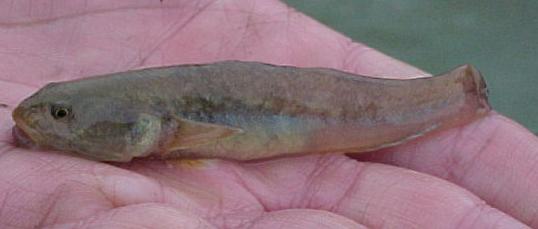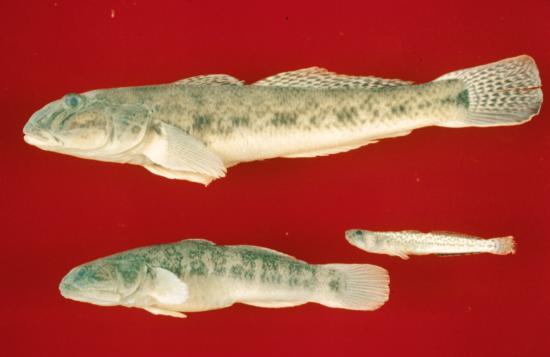Longjaw Mudsucker
-
Scientific NameGillichthys mirabilis
-
NativeYes
-
Identification
 Longjaw mudsucker. Location: Eureka Slough, Humboldt Bay, CA. Date: 2003. Photo by Mike Wallace, California Department of Fish and Game.
Longjaw mudsucker. Location: Eureka Slough, Humboldt Bay, CA. Date: 2003. Photo by Mike Wallace, California Department of Fish and Game. Yellowfin Goby (Top), Arrow Goby (Middle Right) and Longjaw Mudsucker (Bottom). Photo from Camm C. Swift. Museum of Natural History Los Angeles County
Yellowfin Goby (Top), Arrow Goby (Middle Right) and Longjaw Mudsucker (Bottom). Photo from Camm C. Swift. Museum of Natural History Los Angeles County- Goby
- Elongated body
- Max. 150 mm TL, regularly 135-140 mm SL
- Pelvic fins united to form suction cup, 2 dorsal fins,heavy bodied goby
- Terminal mouth, upper jaw nearly reaches opercular opening (jaw reaches rear margin of eye in juveniles)
- Blunt head, small widely-set eyes (eyes more lateral in juveniles)
- Small scales: absent on front of belly, large on caudal peduncle
- Coloration: Dark brown to olive back and sides,yellow bellies, often have faint vertical bars on sides
- Juveniles: 8 vertical bars on sides, dark blotch on posterior side of 1st dorsal fin
- Fin spines/rays: 1st dorsal 4-8 spines, 2nd dorsal 10-17 elements, anal 9-17 elements, pectoral 15-23 rays
- Lateral line scales: 60-100
-
Life History
Longjaw Mudsuckers primarily inhabit shallow sloughs and tidal mudflats in the upper ends of bays and estuaries. They are occasionally found in freshwater but cannot survive more than 3-7 days at such a low salinity level. They can sustain populations in water with salinities ranging from 12 ppt to 82.5 ppt, and in water with a temperature as high as 35°C. As the tide goes out Longjaw Mudsucker survive by burrowing in mud and gulping air. They also have the ability to move short distances across land to reach water. In northern California Longjaw Mudsuckers are commonly found in association with Topsmelt, Yellowfin Goby, Staghorn Sculpin, Rainwater Killifish, and Threespine Stickleback. In southern California Mudsuckers are commonly found around California Killifish, Arrow Goby, and Topsmelt. Their diet changes with the availability of prey. Adult inhabitants of the Salton Sea eat mostly pile worms, while coastal dwellers feed mostly on benthic prey such as algae, isopods, amphipods, and small fish. Longjaw Mudsuckers live approximately 2 years and may reach sexual maturity and a length of 60-80 mm in several months. Growth is rapid during summer and slows during winter. Breeding typically occurs from January through July in the southern distribution and in December-June in the San Francisco Bay. Male Mudsuckers create and defend breeding burrows. Females produce 8,000 to 27,000 eggs and spawn multiple times in a season. Fertilized eggs are attached to the walls of burrows and male fish defend the burrows for 10-12 days till the embryos hatch. Newly emerged larvae are pelagic and settle to the bottom as juveniles when they reach a total length of 8-12 mm.
-
Links to Other ResearchN / A

